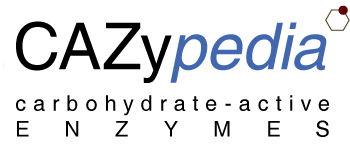11 February 2024: A "BLAST" from the past, with a fresh update. Author Eduardo Moreno Prieto composed a new page on
Glycoside Hydrolase Family 119,a family of bacterial amylases, which was
Curator Approved by
Stefan Janecek and
Bernard Henrissat today. The first member of
GH119 was characterized in 2006, and through sequence analysis with
GH57 members,
Janeček and Kuchtová predicted the active-site residues in 2012. Over a decade later,
Eduardo,
Bernard, and colleagues finally provided critical experimental support for these predictions.
Learn more about this history, and especially the relationship between GH119 and GH57, in CAZypedia.
3 February 2024: A new family of beta-1,2-glucan-cyclizing enzymes. A page on the (currently) newest GH family, Glycoside Hydrolase Family 189, was completed today by Authors Tomoko Masaike, Masahiro Nakajima, and Nobukiyo Tanaka (Masahiro Nakajima is the Responsible Curator). GH189 is a family of bacterial transglycosylases that comprise a critical domain in cyclic beta-1,2-glucan synthase (CGS), because this domain is responsible for the final cyclization step during the biosynthesis of these key effector molecules. The discovery of GH189 builds on similarly exciting work by these authors and their colleagues on beta-1,2-glucan hydrolases in GH144 and GH162, which share a common protein fold with GH189, but have distinct mechansims. Check out the GH189, GH144, and GH162 pages to learn more about this breakthrough work on beta-1,2-glucan-active enzymes!
4 January 2024: CBM99, CBM100 and CBM101 in one fell swoop! Three new CBM families have been added to the CAZypedia repertoire. Though the families differ in their glycan targets, they share the interesting function of binding to highly complex sulfated marine polymers. Yaoguang Chang acted as Responsible Curator on all three pages. Xuanwei Mei authored the CBM99 and CBM101 red algal specific pages and Guanchen Liu authored the CBM100 glycosaminoglycan specific page. Learn more about CBM99, CBM100 and CBM101 on their respective pages!
4 January 2024: More "Fun" from the sea. Today, Yaoguang Chang Curator Approved the Glycoside Hydrolase Family 187 page Authored by Jingjing Shen. The founding member of GH187 is the alpha-1,3-L-fucanase ("Fun187A") the marine bacterium Wenyingzhuangia aestuarii, which recognizes a specific sulfated motif in sea cucumber fucans. GH187 is a small family (<50 members) and there remains much to elucidate regarding catalytic mechanism and enzyme structure. Interest in CAZymes active on marine biomass continues to grow, and we welcome this expansion in CAZypedia. Learn more about GH187 here!
17 December 2023: Redox-assisted glycoside hydrolysis, redux. Just before the turn of the new year, Spencer Williams completed the Glycoside Hydrolase Family 188 page. GH188 is the latest representative of a growing number of Glycoside Hydrolase families, including GH4, GH109, GH177, and GH179, which use an NAD-dependent oxidation-elimination-addition-reduction cycle to cleave glycosidic bonds. First established ca. 20 years ago in GH4, this mechanism is therefore distinct from the canonical Koshland mechanisms of glycoside hydrolysis. Notably, because oxidation occurs at C-3 of the sugar ring, followed by elimination at C-1, these enzymes can cleave both alpha- and beta-glycosides! Recently, Spencer, Ethan Goddard-Borger, and Gideon Davies showed that NAD-dependent hydrolysis also extends to sulfoquinovoside hydrolysis by bacterial GH188 members, complementing canonical sulfoquinovosidases in GH31. Read more about these remarkable enzymes here!
16 August 2023: An oldie but a goodie. The page for CBM9, one of the original founding top 10 Carbohydrate Binding Module Families, has been completed by Johan Larsbrink, who multitasked as both Author and Responsible Curator. CBM9 members are often found in ultra-multimodular, xylan deconstructing, bacterial enzymes, and their cellulose-binding functionality has been exploited as affinity tags in recombinant protein purifications. Read more on this historically important CBM family here!
> older news
